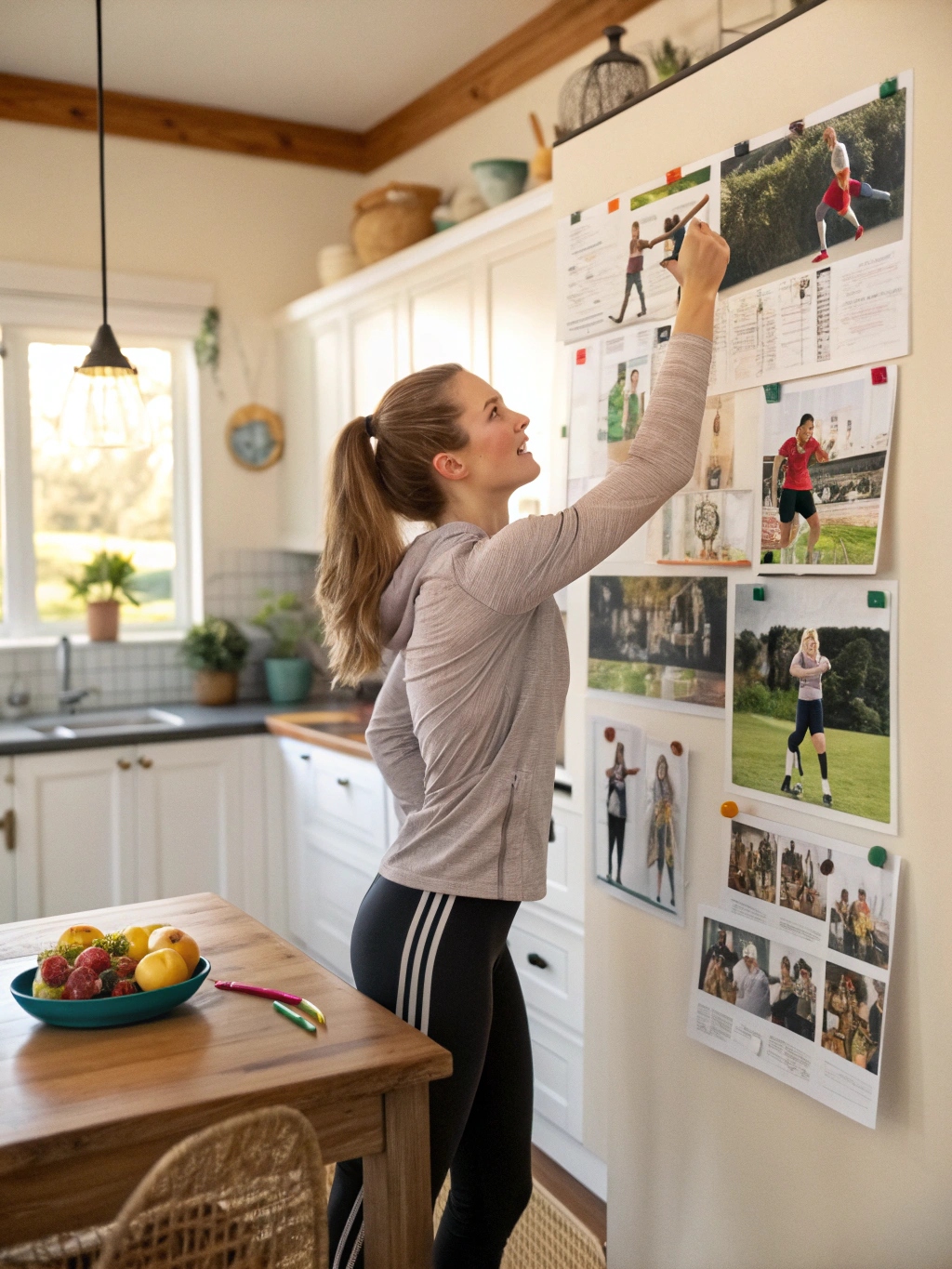Did you know 76% of people who use vision boards for fitness see faster progress? A vision board is more than a collage. It’s a tool that uses brain science to help you change physically. By turning your fitness dreams into a visual plan, you make your goals feel real and reachable.
Make a vision board to remind you of your goals every day. Whether you want to get stronger, last longer in workouts, or live healthier, this guide will help. Use images like sports trophies, motivational quotes, or before/after photos to make it real. These pictures help your brain focus on what you want to achieve.
Adding daily reflection can make you more motivated and accountable. This way, you stay on track with your goals.
Key Takeaways
- Visual cues like sports trophies or fitness quotes can rewire the brain to prioritize physical transformation goals.
- Group images and affirmations into sections like “Workout Routine” or “Healthy Habits” for clear goal categorization.
- Physical or digital tools like Canva or Pinterest make creating a vision board accessible and customizable.
- Updating the board regularly keeps goals fresh and aligns them with progress milestones.
- Placing the board in high-traffic areas like a gym wall boosts daily engagement with your transformation goals.
Understanding the Power of Vision Boards for Physical Goals
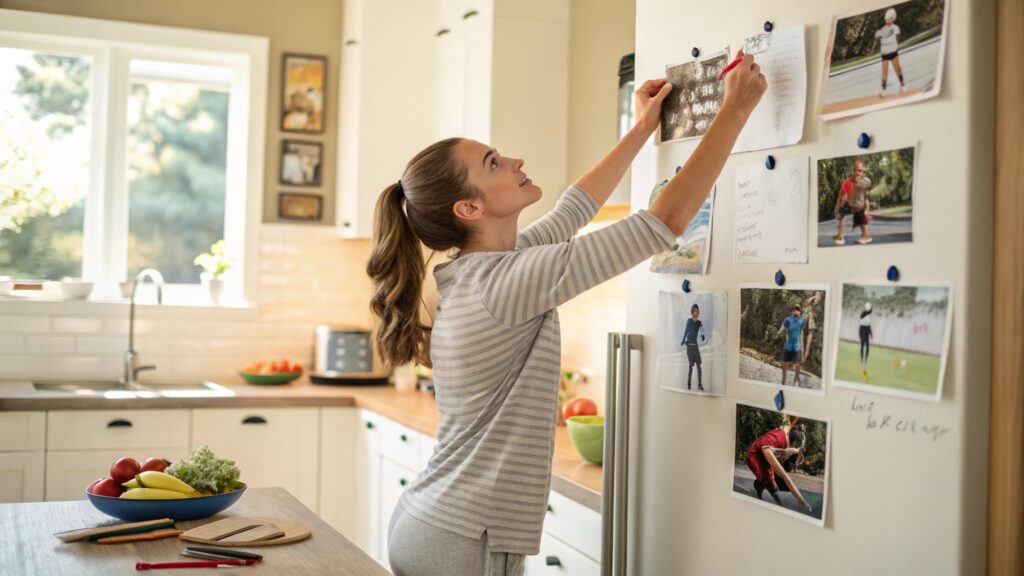
Visualization techniques are more than just a trend. They are based on how our brains work. When you make a vision board, you’re using your brain’s special system to focus on your goals. This system helps you take action towards achieving your fitness goals by making your dreams clear in your mind.
“Athletes who mentally rehearse their performance experience measurable improvements.” — Journal of Applied Sport Psychology, 2020
Here’s how it works:
- Visualization techniques create neural pathways mirroring physical actions, priming your brain for success.
- Goal planning with SMART criteria clarifies what steps to take daily.
- Regular engagement with your board keeps motivation high and distractions at bay.
| Component | Benefit |
|---|---|
| Images of exercise routines | Strengthens mental rehearsal of habits |
| Timeline elements | Breaks goals into manageable steps |
| Positive affirmations | Reinforces self-belief and persistence |
Tools like Canva or Creately’s templates make designing digital vision boards easy. They mix goal planning with visual inspiration. By using science-backed methods, you’re not just pinning photos. You’re creating a roadmap your brain can’t ignore.
How to Create a Vision Board for Your Physical Transformation: Steps and Tips
Starting a vision board for your physical change needs clarity. Steps and tips help make it a strong tool. First, decide what you want: losing weight, gaining muscle, or improving endurance? Write it down to keep your focus sharp.
- Gather materials: Collect magazines, scissors, glue, or use digital tools like Canva or Pinterest. Choose a sturdy poster board or a digital canvas.
- Curate visuals: Clip or download images of fit bodies, workout routines, or healthy meals. Include quotes like “I am strong” or affirmations about health.
- Organize sections: Divide your board into zones for fitness, nutrition, and recovery. Use colors and symbols to represent progress milestones.
- Add personal elements: Write your goals in present tense: “I am energized after workouts” or “I fuel my body with nutritious meals.”
- Display strategically: Place your board where you’ll see it daily—like your bathroom mirror or phone wallpaper. Engage with it daily to reinforce motivation.
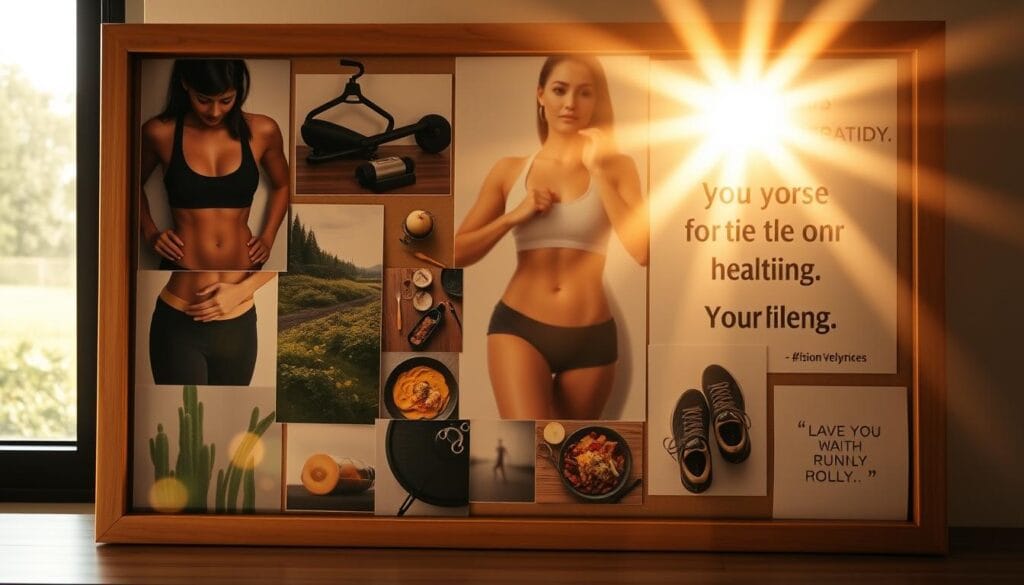
- Include before/after photos of athletes or fitness journeys.
- Add meal plans or workout schedules as visual reminders.
- Use symbols like dumbbells, running shoes, or heart rate monitors to represent activities.
- Highlight milestones like “10kg weight loss” or “5k run completed.”
Update your board as you progress. Replace old images with new goals or celebrate achievements. This keeps your board dynamic and aligned with your evolving journey.
Essential Supplies for Your Physical Transformation Vision Board
Choosing the right tools makes your vision board a daily motivator. Whether it’s physical or digital, the right supplies keep your goals in sight. Let’s look at materials that fit your lifestyle and energy.
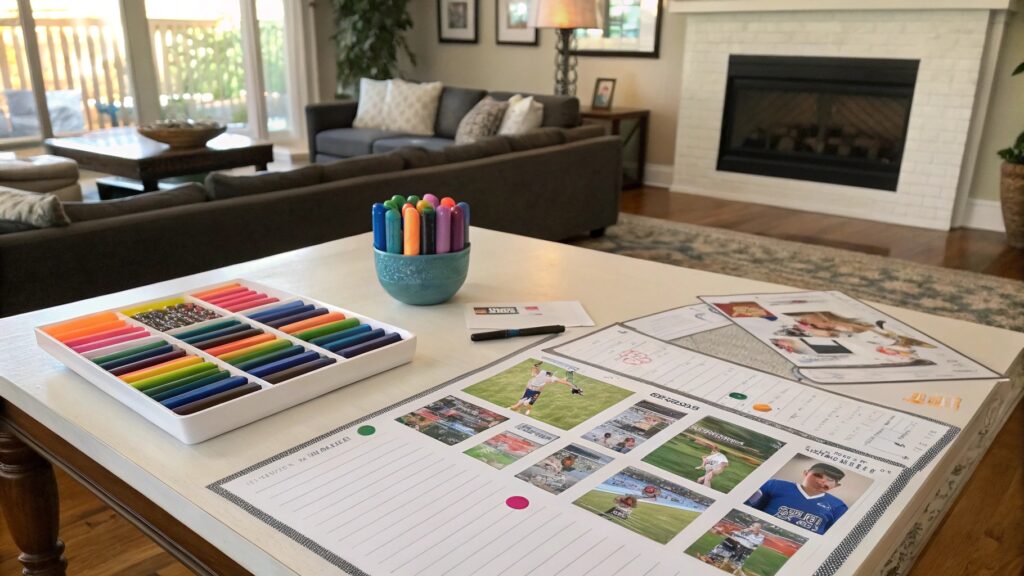
Physical vs. Digital: Pick Your Medium
Physical boards engage your senses. Use sturdy foam boards, cork, or magnetic surfaces for updates. Digital options like Canva or Milanote let you edit anytime on your device. Pick what feels right for you.
- Physical essentials: foam board, washi tape, push pins, or chalk markers. Add motivational quotes or progress charts on poster boards.
- Digital tools: Canva templates, apps like Milanote, or screen savers to display on phones or tablets.
Color choices are key. Red or orange boost energy for workouts, while blue promotes calm focus. Use scissors and glue sticks with workout photos or affirmations to enhance your vision board.
Include timeline stickers or progress trackers. Journals like scrapbooks help log milestones. The right supplies turn your vision board into a dynamic tool. Update it weekly to show your progress.
Defining Your Physical Transformation Goals with Clarity
Before you start making your vision board, goal planning is key. Think about what physical transformation means to you. Is it getting stronger, running longer, or moving better? Write down all your dreams, then make them SMART—Specific, Measurable, Achievable, Relevant, Time-bound.
- Start by listing your fitness goals. Maybe you want to “run a 5K in 6 months” or “lower your resting heart rate by 10 bpm by December.”
- Set deadlines and track your progress. For instance, “reduce body fat to 20% by summer” gives you clear goals.
- Connect your goals to how they’ll make you feel. Ask yourself, “How will this make my life better?”
| Goal Type | Description | Example |
|---|---|---|
| Foundation Goals | Consistent habits like daily hydration or morning stretches | Wake up at 6 AM for 30-day yoga sessions |
| Progression Goals | Increamental steps toward larger targets | Deadlift 135 lbs by March, then 185 lbs by year-end |
| Ultimate Goals | Your final vision (e.g., completing a marathon) | Compete in a powerlifting meet in 2025 |
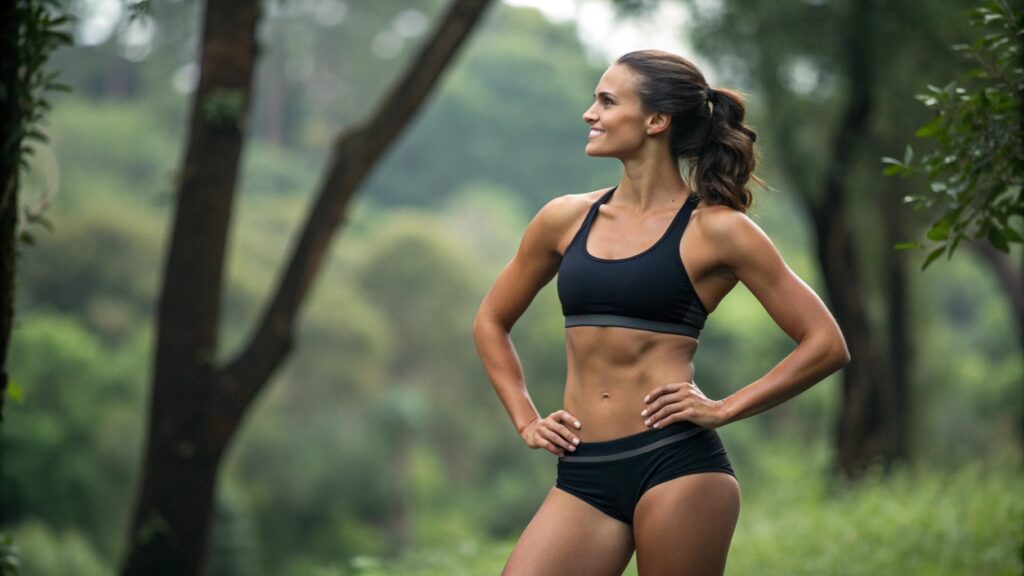
Then, sort your goals into levels of importance. Put your top 3 goals in the center of your board. Use sticky notes to arrange images and affirmations that match these goals. A clear plan makes your vision board a daily motivator, not just a decoration. Keep checking and updating your goals as you move forward, making your physical transformation journey exciting and meaningful.
Selecting Powerful Images That Motivate Your Fitness Journey
Choosing the right images for your vision board turns abstract goals into vivid reminders of your physical transformation journey. Effective focus on both inspiration and practical steps. They blend aspirational visuals with actionable cues. Start by curating photos that resonate emotionally, not just aesthetically.
Before and After Photos: Using Them Effectively
Use relatable before-and-after images showing realistic progress. Studies show motivation peaks when visuals mirror your current stage and achievable goals. Avoid overly idealized images; instead, pick examples where people share similar starting points to yours.
Including Inspirational Quotes and Affirmations
“Strength doesn’t come from what you can do. It comes from overcoming the things you once thought you couldn’t.” – Ronda Rousey
Add quotes from fitness leaders like Ronda Rousey or Jillian Michaels. Handwritten affirmations like “I embrace progress, not perfection” reinforce daily mindset shifts.
Representing Both Process and End Results
| Type | Examples |
|---|---|
| Process | Workout routines, meal prep, recovery stretches |
| End Results | Confident poses, active hobbies, lifestyle changes |
Adding Timeline Elements to Your Vision Board
- Add calendar markers for 30-day, 90-day, and 180-day goals
- Include checklists for weekly habits (e.g., “3x weekly strength training”)
- Use color-coded sections for completed vs. upcoming milestones
Pair timelines with photos of your ideal self at each stage to visualize progress. Update them monthly to stay aligned with your physical transformation path.
Strategic Placement: Where to Display Your Vision Board for Maximum Impact
Your vision board works best when it’s in a spot that affects your daily life. To make it more effective, place it where you make choices often. This way, it can help you reach your goals more easily.
Put your board in places where you make decisions. Here are some great spots:
- Kitchen: Near the pantry to guide meal choices
- Home workout area: Face the mirror during exercise
- Bedside: Review before sleep and upon waking
- Work desk: A daily reminder during screen time
| Color | Psychological Effect | Best Placement |
|---|---|---|
| Blue | Promotes calm focus | Home office |
| Green | Encourages growth | Yoga mat wall |
| Red | Ignites motivation | Gym bag or car dashboard |
For privacy, use digital options like Canva’s app or a laptop wallpaper. This way, you can keep your goals private but visible. Set it as your lock screen to start your day with a reminder.
Make small vision boards for different areas. A tiny fitness tracker sticker on your fridge can remind you to stay active. Seeing it often, like during meals or workouts, helps you stay focused.
Activating Your Vision Board Through Daily Practices
Creating a vision board is just the start. To make it work, you need to engage with it every day. Start by spending 3–5 minutes each morning looking at your board. This helps your mind stay focused on your achieving your fitness goals.
Keep your board somewhere you can’t ignore, like your kitchen counter or phone screen. This way, your goals will always be in sight.
- Morning ritual: Review your board and say affirmations like “I am strong” to boost your confidence.
- Physical mimicry: Stand up straight like your future self when you look at your board. Research shows this can help you stay focused on your goals.
- Journal entries: Write down how each image makes you feel and what step you can take today to move closer to it.
- Moment check-ins: Look at your board before meals or workouts to remind yourself of your goals.
Science backs up why this works. Your brain’s RAS system focuses on what you keep visualizing. Use tools like Canva to update your board and meditation to help you stay focused. It’s not just about looking at pictures—it’s about having a daily conversation between your vision and your actions.
When you feel hungry or tired, your board becomes a guide. It helps you stay on track, even when it’s hard.
Updating Your Vision Board as You Progress
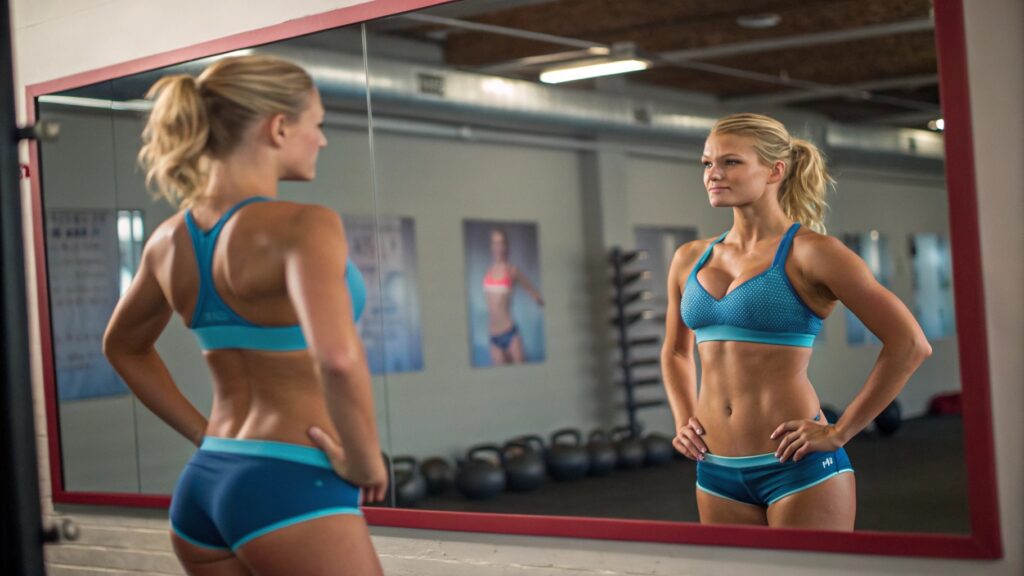
Your physical transformation journey changes, so does your vision board. Regular updates keep your transformation goals in line with your growth. Make it a habit to review your board every month.
When to Update:
- Swap out old images with new transformation goals when you reach them.
- Take away goals you’ve already hit and add new ones to keep you motivated.
- Bring in fresh quotes or affirmations to keep your focus sharp.
Celebrate Milestones:
Move achieved goals to a “victory section” or scrapbook. Add photos or notes to celebrate your progress. For example, after running your first 5K, display a medal image alongside your next race target. This visual reminder fuels your drive.
Adjust Timelines Realistically:
If a goal planning milestone seems too hard, break it down into smaller steps. Use the SMART framework (Specific, Measurable, Achievable, Relevant, Time-bound) to make your goals more realistic. This way, your board stays a tool for growth, not a reminder of what you can’t do.
Your vision board is a dynamic roadmap. By updating it every quarter or after reaching milestones, you celebrate your past wins and plan for the future. This keeps your physical transformation journey vibrant and flexible.
Combining Vision Boards with Action Plans for Guaranteed Results
Creating a vision board is just the start. To reach your fitness goals, you need a solid action plan. Goal setting is key to making your vision a reality. Here’s how to make it happen:
“Setting goals is the first step in turning the invisible into the visible.” – Tony Robbins
- Connect each image on your board to a specific action. For instance, a photo of toned arms could be linked to a 3x-week arm workout plan.
- Use apps like Pinterest or MyFitnessPal to track your meals, workouts, and progress. Keep your vision board in mind.
- Update your action plan every week. Reflect on new goals and achievements. Change your board as needed.
When making a vision board, include steps you can take. Write your workout schedule next to your images. Add meal prep checklists or sleep trackers. See your goals every day and take action right after.
Combine your vision with tools like Liberty’s Inspiration Hub or fitness apps. Your vision board is more than art—it’s a guide. Add weekly check-ins, habit trackers, and clear goals. Celebrate small victories to keep moving forward.
Remember, a vision board alone is just a pretty picture. Make your dreams real with daily routines. The mix of visual inspiration and goal setting turns dreams into action.
Conclusion: Transforming Your Physical Reality Through Consistent Visualization
Your vision board is more than just pictures. It’s a guide to changing your body and life. By using images of workouts, healthy food, and positive thoughts, you remind yourself of your goals every day. When you add new photos or achievements, you strengthen your habits.
Seeing your dream self isn’t just daydreaming. It’s a mix of seeing it and doing it. You track your food, stick to your workout plans, and celebrate your small victories. This way, your brain gets ready to make choices that help you reach your goals. Whether it’s on your wall or in an app, keep looking at it to stay focused.
Changing your body takes time. Let your board grow with you, adding new goals and habits. When things get tough, look at your board to remember why you started. By combining your mental focus with daily actions, your vision board shows you that your dreams are possible with hard work and clear goals.
FAQ
What is a vision board for physical transformation?
A vision board is a visual tool for fitness goals. It uses images, quotes, and milestones to show what you want to achieve. It’s a powerful way to represent your fitness journey.
How does visualization impact physical transformation?
Visualization works by activating brain pathways that mimic achieving your goals. By seeing your desired physique, you boost motivation and stick to your fitness plan.
What should I include on my physical transformation vision board?
Your board should have images, before-and-after pictures, and quotes. Add lifestyle benefits and progress tracking to guide your transformation.
Where should I place my vision board for maximum effectiveness?
Put your board in places you see often, like near your gym or kitchen. This keeps your goals in mind when you make decisions.
How often should I update my vision board?
Update your board monthly to show your progress and new goals. This keeps it relevant and motivating as you reach milestones.
Can I use a digital vision board instead of a physical one?
Yes! Digital boards are great for updates and customization. Use apps or software to create a space with images, videos, and quotes for your fitness goals.
How do I maintain motivation while working toward my transformation goals?
Interact with your board daily through journaling, mini-routines, and celebrating small wins. These actions keep you committed and motivated.
What if I don’t achieve my initial transformation goals?
Adjust your goals and timelines based on your body’s feedback. Use your board to make changes and celebrate progress, not just the end result.
